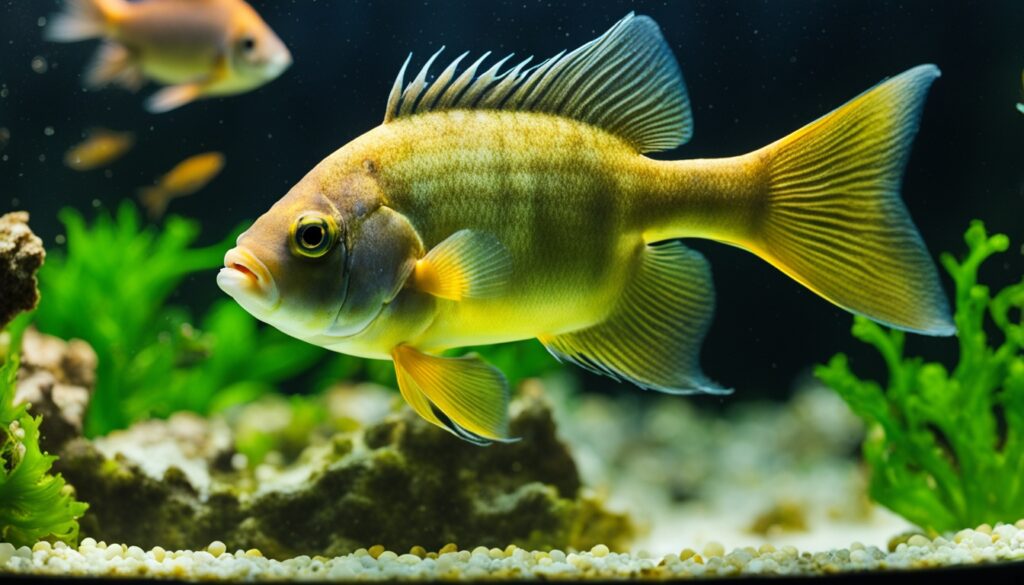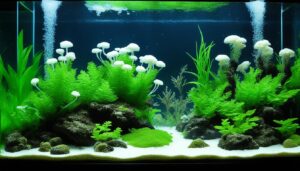In this article, we’re diving into the battle against black beard algae, often referred to as BBA. We’ll break down why it shows up, how to get rid of it, and most importantly, how to keep it from coming back.
Black beard algae is a common headache for freshwater aquarium owners. It’s stubborn, clings to everything in the tank, and doesn’t discriminate between decorations or plants. The main culprit behind its growth is often an imbalance of nutrients, usually from poor tank maintenance, excess nutrients, or improper lighting.
Overfeeding your fish or overcrowding the tank can lead to an overload of waste, creating the perfect environment for black beard algae to thrive. Without enough CO2, the problem can escalate quickly, as this algae can smother your plants by hogging the light and nutrients they need.
But don’t worry, you’re not out of options. There are effective ways to fight back. Liquid carbon products or hydrogen peroxide can be used to kill BBA. Adding algae-eating fish like Siamese Algae Eaters or Amano Shrimp can also help keep it under control. Additionally, there are specific products designed to target black beard algae.
Prevention is key when it comes to keeping black beard algae at bay. Regular tank maintenance is crucial—cleaning your tank, controlling how much you feed your fish, and keeping CO2 levels steady are all important steps. With the right approach, your plants will stay healthy, and algae won’t stand a chance.
Black Beard Algae in Your Aquarium

When you look into your fish tank, you might see a dark plant called Black Beard Algae (BBA). It’s common on decorations and plants in many aquariums. Knowing how to spot black beard algae is key to keeping your tank healthy and looking good. This algae, though harmless, can harm plants by taking their nutrients and light.
The Nature and Identification of Black Beard Algae
Black beard algae stands out in your tank with its dark green or black, brush-like look. It grows slowly and forms thick, hair-like strands that stick to hard surfaces. You’ll often find it on plants, the ground, and tank parts. It likes places with lots of nutrients and where the water doesn’t move much.
Common Habitats and Growth Patterns in Aquariums
Black beard algae grows well in certain conditions, especially where CO2 levels change and water flow is slow. It sticks to rough surfaces, making it hard to remove. This is important to remember when dealing with black beard algae in.
Condition |
Detail |
|---|---|
Preferred Surfaces |
Rough/Textured |
CO2 Levels |
Fluctuating |
Common Locations |
Edges of leaves, wood, silicon seals |
Water Flow |
Low/Inconsistent |
Prevention/Control |
Regular water changes, balanced nutrients, CO2 supplementation |
For those managing aquariums, it’s crucial to watch and control black beard algae. Keeping your tank balanced helps stop it from growing too much. This not only makes your tank look better but also helps your plants and fish stay healthy.
Common Causes of Black Beard Algae Infestations

Understanding the causes of black beard algae is key to keeping aquariums healthy. These infestations often start from nutrient imbalances. This imbalance can come from overfeeding, too many fish, poor filters, or too much light.
Phosphates in tap water are a big problem for black beard algae. About 80% of the time, these algae grow because of phosphates in the water. When phosphates build up, along with CO2 changes, it’s perfect for algae to grow.
Black beard algae do well in places with unstable CO2 levels. They can take carbon from hydrogen carbonate, changing the water chemistry. This makes controlling black beard algae hard. You need to be careful with water chemistry and nutrients.
- Changing the water often helps lower phosphate and nutrient levels.
- Keeping CO2 levels steady is crucial.
- Less light reduces algae growth.
To stop black beard algae before it starts, add algae eaters like Siamese Algae Eaters or Bristlenose Pleco. These fish eat algae, keeping the tank balanced.
When fighting black beard algae, watch how much you feed your fish. Too much food means more nutrients for algae. Also, having healthy plants can stop algae from taking over. Plants compete with algae for nutrients.
- Check the water for phosphates often, keeping them under 1 ppm.
- Use products to remove phosphates if they’re too high.
- Adjust your lighting so it’s good for plants but not for algae.
People who keep their tanks balanced have fewer problems with black beard algae. A stable tank means happy fish, plants, and water conditions. This balance stops algae from becoming a big issue.
Black Beard Algae: Not Harmful to Fish but a Threat to Plants

Black beard algae in tanks are usually safe for fish and snails. But, they can harm aquatic plants. They attach to plant leaves, blocking light and nutrients. This can kill plants by suffocating them.
Black beard algae grows well when plants are stressed or lack nutrients. To stop them, keep CO2 levels stable. Also, remove old or infested leaves to help your plants grow back.
This approach reduces algae and helps your plants. It keeps your tank looking good and healthy.
Parameter |
Value |
|---|---|
Main Tank Volume |
260L |
Quarantine Tank Volume |
180L |
Water pH |
6.6 |
Nitrate Level |
10 ppm |
Lighting Duration |
8 hours/day |
Algae Control Suggestion |
Adjust lighting, Excel dosing, manual scrubbing |
Many hobbyists don’t realize how harmful black beard algae can be until it’s too late. To prevent it, adjust the lighting and feed your fish right. Shorten the light time or use less intense lights to stop algae growth.
Adding algae-eating fish like bristlenose plecos or nerite snails can also help. These fish eat algae naturally, keeping your tank balanced.
To manage black beard algae, maintain your tank well and act fast if you see algae. Make sure your tank’s conditions don’t let algae outcompete plants and fish. A healthy tank has diverse life without invasive algae like black beard algae.
The Battle Against Black Beard Algae: Effective Removal Techniques
As an aquarium enthusiast, I know how annoying black beard algae (BBA) can be. I’ve looked into many ways to remove it. Finding the right method depends on your aquarium’s details.
Liquid Carbon Use and Its Effectiveness
I’ve found liquid carbon products like Seachem’s Flourish Excel helpful. They stop BBA from growing and work well as spot treatments. I dip infected decor and plants in them to keep CO2 levels right without encouraging BBA.
Hydrogen Peroxide: A Household Solution
Hydrogen peroxide has been a big help for me. Mixing one part 3-5% hydrogen peroxide with three parts aquarium water and applying it directly to BBA works great. But, watch your fish for stress signs and change the water by 50% to remove chemicals and dead algae. When the algae turns reddish-brown and bubbles appear, it means you’re winning.
Biological Control: Enlisting Algae-Eating Aquatic Life
Using algae-eating creatures has also been key. Fish like Siamese Algae Eaters, Amano Shrimp, or Nerite Snails eat BBA. Along with products like SL-Aqua’s Z3 BBA Remover, this keeps BBA under control safely.
Specialized Algae Removal Products
Specialized products have also been crucial in fighting BBA. They’re safe for fish and effective at removing algae. I follow the instructions closely to avoid overusing them. Regular water changes and balancing nutrients are still essential for keeping algae away.








